Several cross-border payments companies have recently surpassed $1bn in revenue – a major milestone for the industry. We compare these companies to identify shared factors and highlight current industry trends.

In recent years, multiple cross-border payments companies have surpassed $1bn in yearly revenue for the first time. This not only highlights the continued strength of the industry and the speed at which disruptors are growing, but also shows the impact of macroeconomic trends on some segments of the cross-border payments space.
Understanding how these businesses generate such high revenue every year provides useful insights to the space – both as case studies for industry peers and as a reflection of how wider factors, such as the pandemic and inflation, affect companies’ bottom lines. With this in mind, in this report we analyse companies that recently passed $1bn in yearly revenue to determine key trends, focusing on factors such as their age, focus and how they have managed to pass this milestone.
Several companies that operate in cross-border payments have been delivering more than $1bn in revenue for a long time. Western Union, Fiserv and PayPal delivered annual revenues of $4.4bn, $19.1bn and $29.8bn respectively in 2023, while MoneyGram achieved a total revenue of $1.3bn in 2022, the last year it reported earnings before going private. However, this report focuses on cross-border companies that have publicly reported revenues of over $1bn recently; are projected to surpass this figure soon; or are set to do so if they continue on their current growth trajectory.
In some cases where appropriate, we’ve broken out the specific revenues for certain companies that are relevant to cross-border payments. For example, in the case of Corpay, figures are related to its Corporate Payments segment, while for Euronet we have identified revenues specifically for its consumer money transfers segment (Ria, Xe).
Analysing revenue growth for $1bn cross-border payments companies
In terms of customer focus, businesses that have surpassed $1bn in yearly revenue in the last few years or are set to do so within the next year or so span a variety of customer types and offerings, including remittances and money transfers, B2B payments, payment processing and merchant acceptance.
They also included companies of various ages, including younger challengers such as Revolut versus longer-standing players such as foreign exchange incumbent Travelex and Dutch ecommerce specialist Adyen.
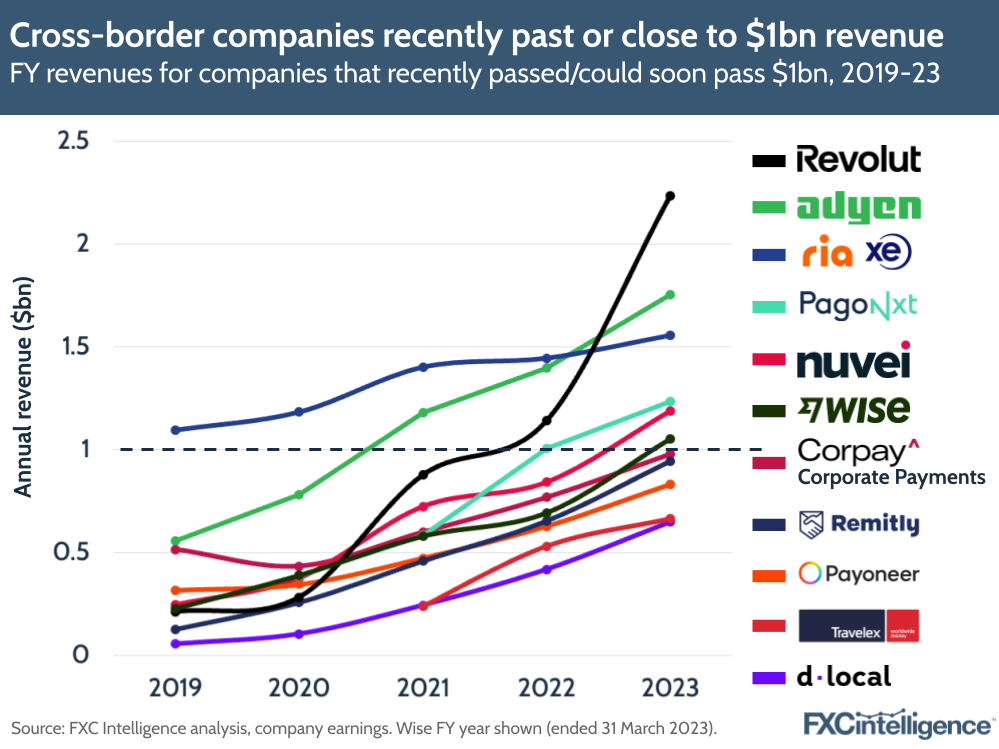
A number of companies are set to surpass $1bn in yearly revenue soon if they achieve their most up-to-date outlook given in earnings calls, of if they continue to see the same YoY revenue growth as last year. For example, money transfers player Remitly is projected to pass $1.2bn in revenue in 2024, while Payoneer expects to grow to $920m-930m in 2024. However, if Payoneer were to see this growth rate again the following year, the company would pass $1bn revenue in FY 2025.
While the core focuses of many of these companies are different, it’s notable that several companies saw significant impacts to their revenue growth rates in 2020-2021, with Covid-19 being a crucial factor. For example, foreign exchange company Travelex saw a significant revenue drop over this period as travel restrictions affected demand for its services, prompting it to enter administration and undergo a complete restructuring.
On the other hand, payment processors benefited from a growth in digital ecommerce during the pandemic. Uruguay-based dLocal saw a surge of volume across its clients in ride-hailing, streaming and advertising, leading it to almost triple its total payment volumes in 2021. The company could surpass $1bn in annual revenues this year if it maintains last year’s YoY growth rate, although given its H1 results it is more likely to do so in FY 2025. Canada-based processor Nuvei, meanwhile also benefited from a surge of digital payments in 2021, seeing revenues rise 93%, although this was also aided by an acquisition.
Significantly, a key driver for a number of players in the space recently has been interest income, particularly for Wise, Payoneer and Revolut. The latter saw interest income rise by 502% in 2023 and take a 28% share of Revolut’s overall revenue for that year. However, slowing inflation and potential central banks rate cuts could change the impact interest income has on these companies.
Analysing profitability of $1bn cross-border payment companies
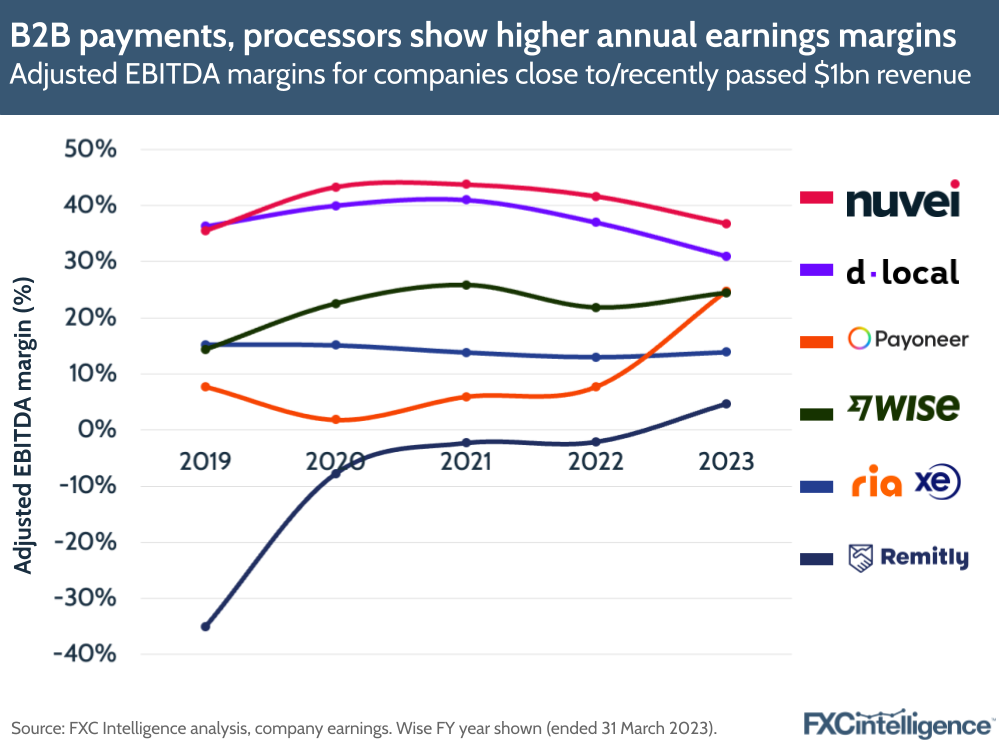
Notably, for companies that share adjusted EBITDA as a profitability measure, this metric looks quite different for a few of the assessed companies. Remitly only reported its first positive adjusted EBITDA margin in 2023, and still reported a net loss of $117.8m that year. Meanwhile, Payoneer has seen solid revenue growth on an annual basis but has historically seen a lower adjusted EBITDA margin than other players in the space (though it expanded significantly to 25% in 2023).
Adyen, Corpay’s Corporate Payments division and Travelex all report EBITDA rather than adjusted EBITDA, achieving margins of 46%, 47% and 11% respectively.
B2B-focused players on this list – Corpay’s Corporate Payments division and Nuvei – and ecommerce players – Adyen and dLocal – tend to have a better track record for EBITDA or adjusted EBITDA margin than the money transfers and remittances players, including Wise, Euronet, Travelex and Remitly. The exception to this historically is Payoneer, though the company did overtake Wise and Euronet on annual adjusted EBITDA margin in 2023.
$1bn cross-border companies vary on employee numbers
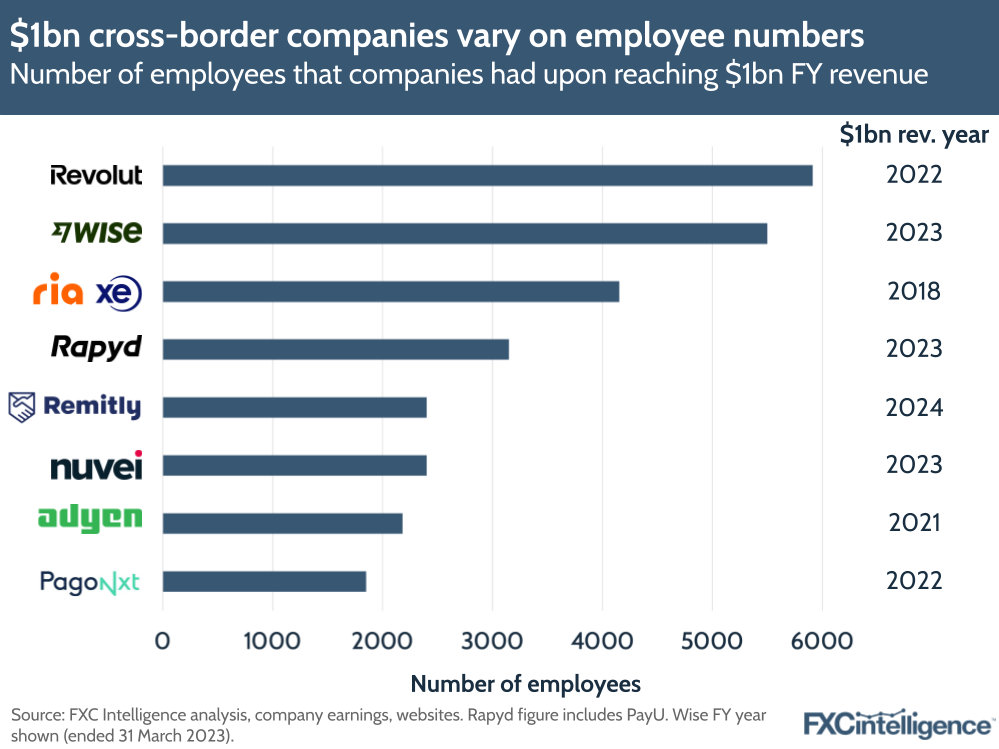
Among companies that have surpassed $1bn in annual revenues recently, all of these had more than 1,000 employees in the year that they reached this milestone, according to the most recent figures available. However, companies have reached this milestone with a wide range of employee numbers.
Both Wise and Revolut have used substantial backing from investors to grow their employee base in a short amount of time, with Wise having had around 5,500 employees in the year when it hit $1bn in annual revenue, while Revolut had just over 5,900.
The speed of this is particularly significant when comparing against other players in the industry that have been around for longer, such as Nuvei, which was at 2,400 employees and around 20 years old when it achieved $1bn in annual revenue, and Adyen, which was 15 years old and had 2,180 when it reached this milestone.
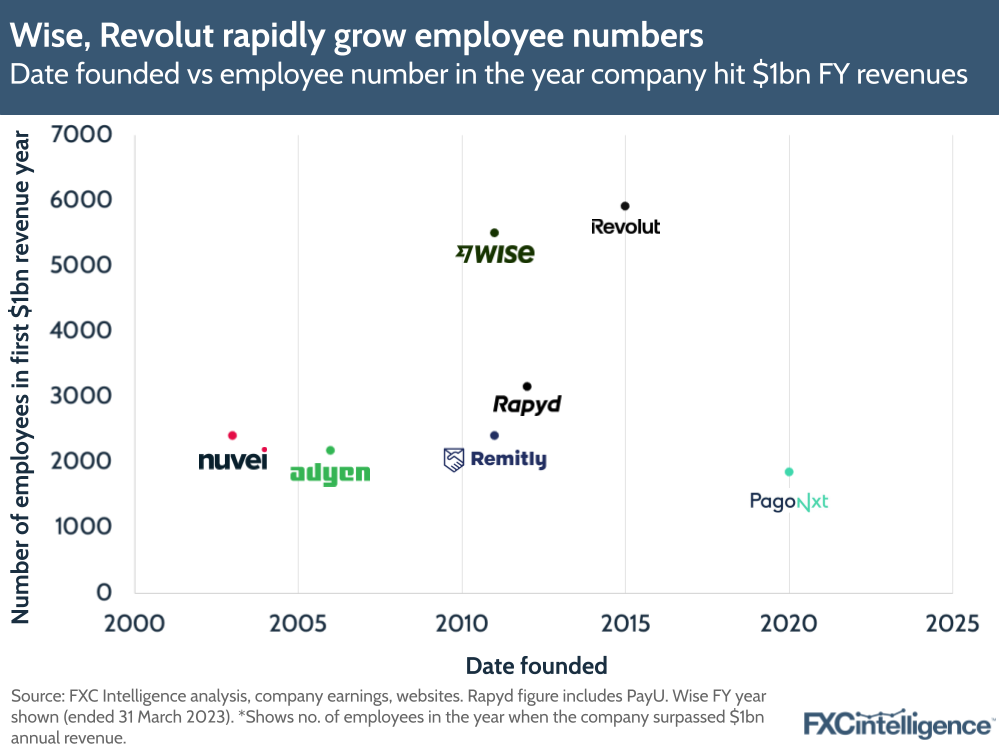
Customer acquisition and retention are helping to drive growth
Comparing companies based on the numbers of customers they have acquired is difficult, given that customer numbers aren’t always reported and the company’s discussed in this report have different offerings and customer types. However, it’s notable that customer acquisition has been a major source of investment for digital challengers, which have continued to rapidly scale their businesses to new geographies while tapping into customer demand for digital payments.
Looking closer at Remitly as an example, the strategy has been to build out its scale and drive efficiency as it grows, in turn gaining customers through word of mouth and retaining them with reliable services, as well as conducting highly localised marketing campaigns.
Overall, the company saw customers grow to 5.9 million by the end of 2023, but its marketing spend for FY 2023 took up a significantly higher share than other money transfer competitors, at 23% of revenue.
In addition to acquiring customers, retaining them has also been important. As part of its current strategy, for example, Payoneer has been focused on ideal customer profiles: customers who have over $500 in volume per month through the company’s platform. This focuses on customers who provide a sustainable source of revenue and who can be sold a greater range of products over time.
Recently founded challengers passed $1bn faster than incumbents
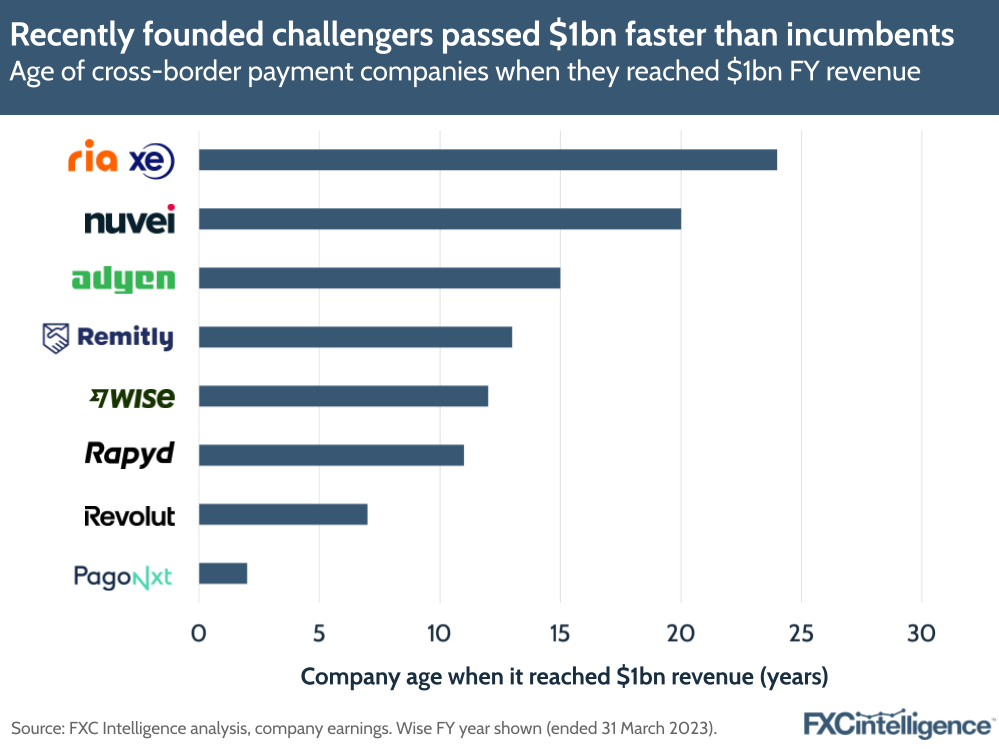
Looking at the age companies are when they surpass the $1bn yearly revenue milestone also shows how recently founded digital challengers have grown rapidly when it comes to revenue. MoneyGram, Ria and Xe all took a significantly longer time to reach the milestone than Wise, Rapyd, Revolut and PagoNxt.
Acquisitions have been key to passing the revenue milestone in some cases, particularly for some of the younger companies on this list. For example, the speed of PagoNxt’s revenue growth demonstrates the strength of having a large bank backing the company. Prior to and around the launch of the company, owner Santander was actively making acquisitions in the payments space, including B2B payments platform Ebury and merchant acceptance provider Getnet, to help it rapidly grow across markets.
Similarly, Rapyd saw a significant contribution from its acquisition of B2B-focused processor PayU GPO last year, which contributed to the company achieving combined revenue of $1bn that year, while Corpay’s acquisition-led strategy has seen it not only shift towards B2B payments but also rebrand itself: the company was formerly Fleetcor before adopting the name of its corporate payments division.
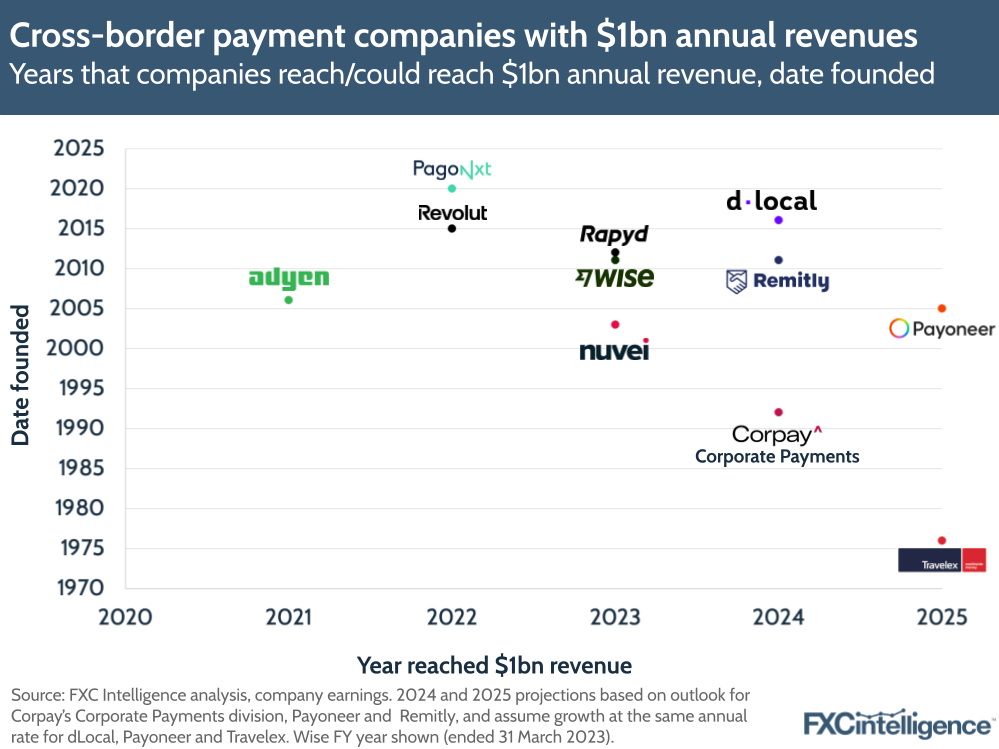
As we’ve found both in discussions with CEOs and in analysis of cross-border payment companies, diversifying across a variety of revenue streams and markets has been key to maintaining strength in revenues – particularly when macroeconomic events such as war, economic slowdown or pandemics create unexpected headwinds or uplifts. However, for some of the most recent success stories in the industry, high levels of funding and investment has also played a major role in rapid growth, particularly when it comes to acquiring new customers.



